light PONTIAC PONTIAC 1997 Owners Manual
[x] Cancel search | Manufacturer: PONTIAC, Model Year: 1997, Model line: PONTIAC, Model: PONTIAC PONTIAC 1997Pages: 419, PDF Size: 19.67 MB
Page 7 of 419
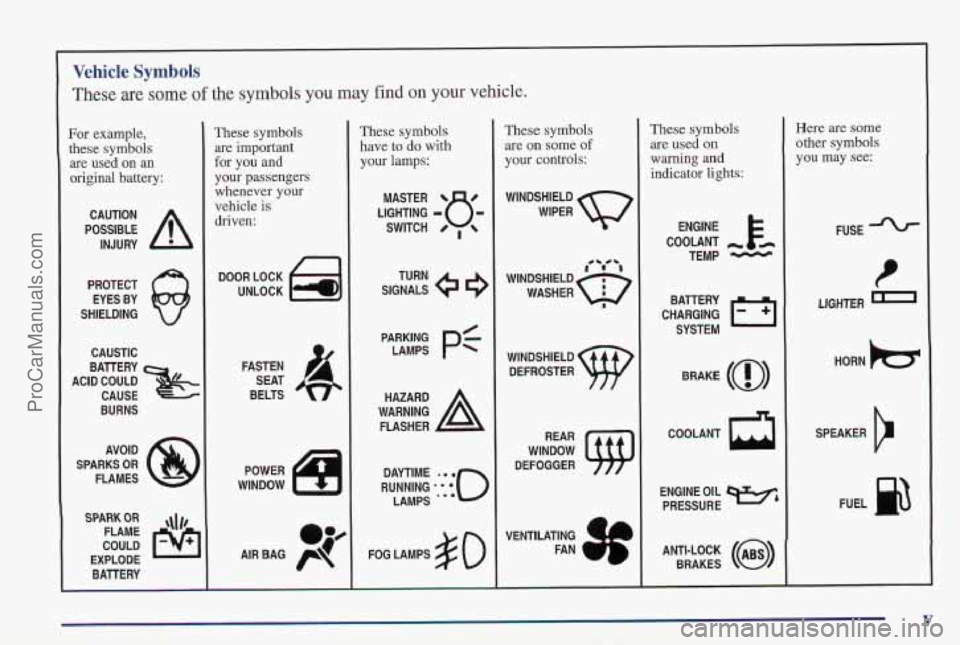
Vehicle Symbols
These are some of the symbols you may find on your vehicle.
For example,
these symbols are used on an
original battery:
POSSIBLE A
CAUTION
INJURY
PROTECT EYES BY
SHIELDING
CAUSTIC
BURNS AVOID
SPARKS
OR
FLAMES
SPARK OR ,\[I,
COULD FLAME
EXPLODE BATTERY
These symbols are important
for you and
your passengers
whenever your
vehicle is
driven:
n
FASTEN
SEAT
BELTS
q4
AIR BAG p
These symbols
have to do with
your lamps:
SIGNALS e
TURN
PARKING LAMPS
FOG LAMPS
$0
These symbols
are
on some of
your controls:
WINDSHIELD
WIPER
WINDSHIELD DEFROSTER
WINDOW
DEFOGGER
VENTILATING
~3
FAN
These symbols are used
on
warning and indicator lights:
COOLANT -
TEMP -
CHARGING BATTERY
SYSTEM
BRAKE
(0)
h
COOLANT
ENGINE OIL
w,
PRESSURE
ANTI-LOCK
(@)
BRAKES
Here are some
other symbols
you may see:
FUSE
P
LIGHTER m
HORN )cr
SPEAKER
b
FUEL la
V
ProCarManuals.com
Page 17 of 419
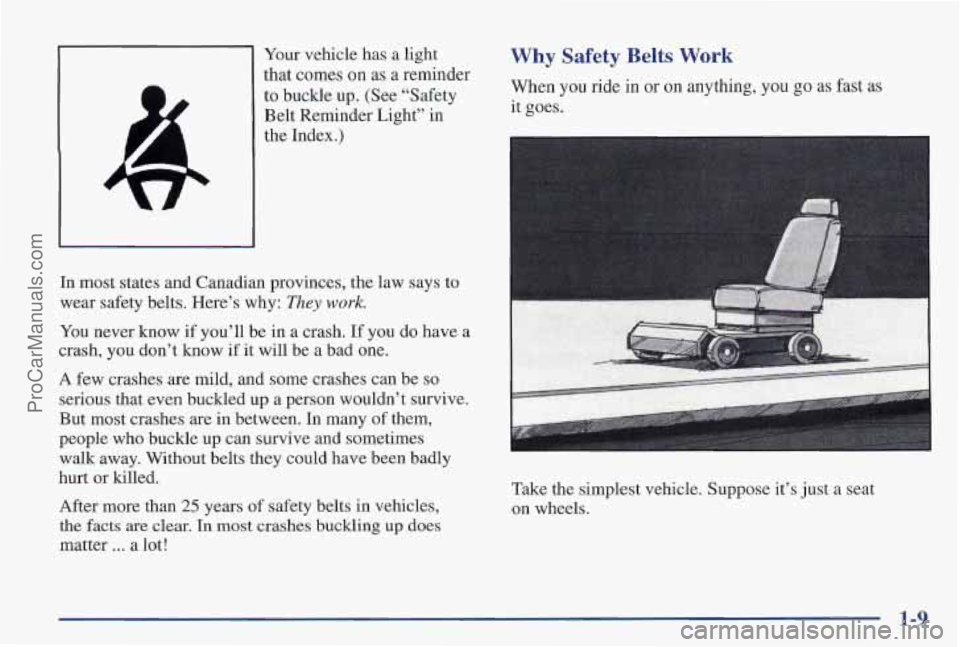
Your vehicle has a light
that comes on as a reminder
to buckle up. (See “Safety
Belt Reminder Light” in
the Index.)
In most states and Canadian provinces, the law says to
wear safety belts. Here’s why:
They work.
You never know if you’ll be in a crash. If you do have a
crash, you don’t know if it will be a bad one.
A few crashes are mild, and some crashes can be so
serious that even buckled up a person wouldn’t survive.
But most crashes are in between. In many of them,
people who buckle up can survive and sometimes
walk away. Without belts they could have been badly
hurt or killed.
After more than
25 years of safety belts in vehicles,
the facts are clear. In most crashes buckling up does
matter
... a lot!
Why Safety Belts Work
When you ride in or on anything, you go as fast as
it goes.
Take the simplest vehicle. Suppose it’s just a seat
on wheels.
1-9
ProCarManuals.com
Page 22 of 419

How to Wear Safety Belts Properly
Adults
This part is only for people of adult size.
Be aware that there
are special things to know about
safety belts and children. And there are different rules
for smaller children and babies. If a child will be
riding in your Pontiae, see the part of this manual
called “Children.” Follow those rules
for
everyone’s protection.
First, you’ll want to know which restraint systems your
vehicle has.
We’ll start with the driver position.
Driver Position
This part describes the driver’s restraint system.
Lap-Shoulder Belt
The driver has a lap-shoulder belt. Here’s how to wear
it properly.
I. Close and lock the door.
2. Adjust the seat (to see how, see “Seats” in the Index)
so you can sit up straight.
3. Pick up the latch plate and pull the belt across you.
Don’t let it get twisted.
The shoulder belt may
lock if you pull the belt across
you very quickly. If this happens, let the belt
go back
slightly
to unlock it. Then pull the belt across you
more slowly.
1-14
ProCarManuals.com
Page 31 of 419

I A CAUTION:
Air bags inflate with great force, faster than the
blink of an eye. If you’re too close to an inflating
air bag,
it could seriously injure you. Safety belts
help keep you in position before and during a
crash. Always wear your safety belt, even with
air
bags. The driver should sit as far back as possible
while still maintaining control
of the vehicle.
SRS AIR BAG
There is an air bag readiness
light on the instrument
panel, which shows SRS
AIR BAG.
An inflating air bag can seriously injure small
children. Always secure children properly in your
vehicle.
To read how, see the part of this manual
called Whildren” and the caution label on the
right front passenger’s safety belt.
The system checks the air bag electrical system for
malfunctions. The light tells
you if there is an electrical
problem. See “Air Bag Readiness Light” in
the Index
I for more information.
1-23
ProCarManuals.com
Page 38 of 419
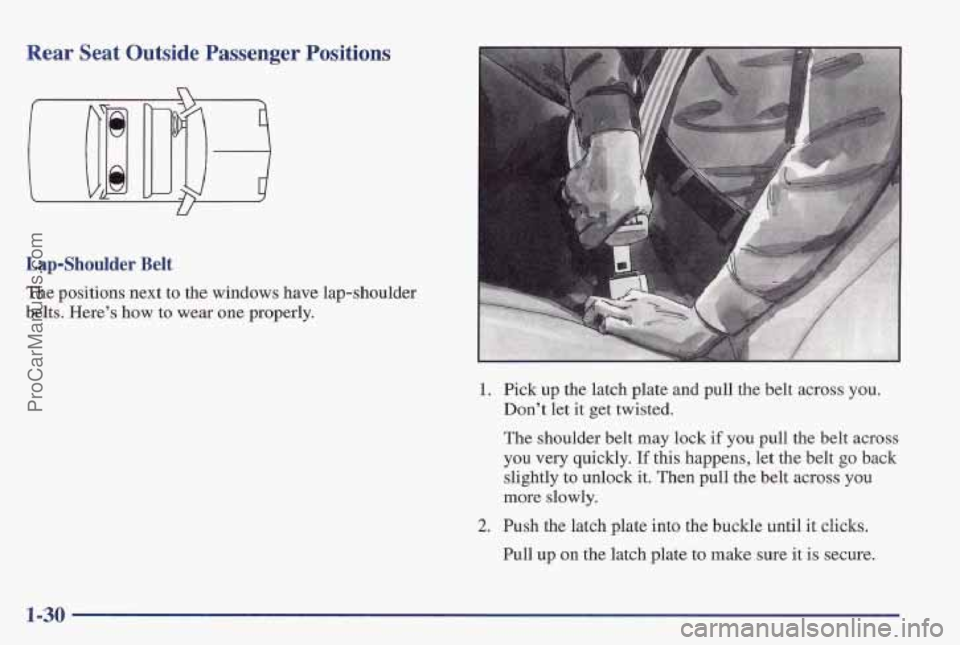
Rear Seat Outside Passenger Positions
Lap-Shoulder Belt
The positions next to the windows have lap-shoulder
belts. Here’s how
to wear one properly.
1. Pick up the latch plate and pull the belt across you. Don’t let
it get twisted.
The shoulder belt may lock if you pull the belt across
you very quickly.
If this happens, let the belt go back
slightly
to unlock it. Then pull the belt across you
more slowly.
2. Push the latch plate into the buckle until it clicks.
Pull
up on the latch plate to make sure it is secure.
1-30
ProCarManuals.com
Page 50 of 419
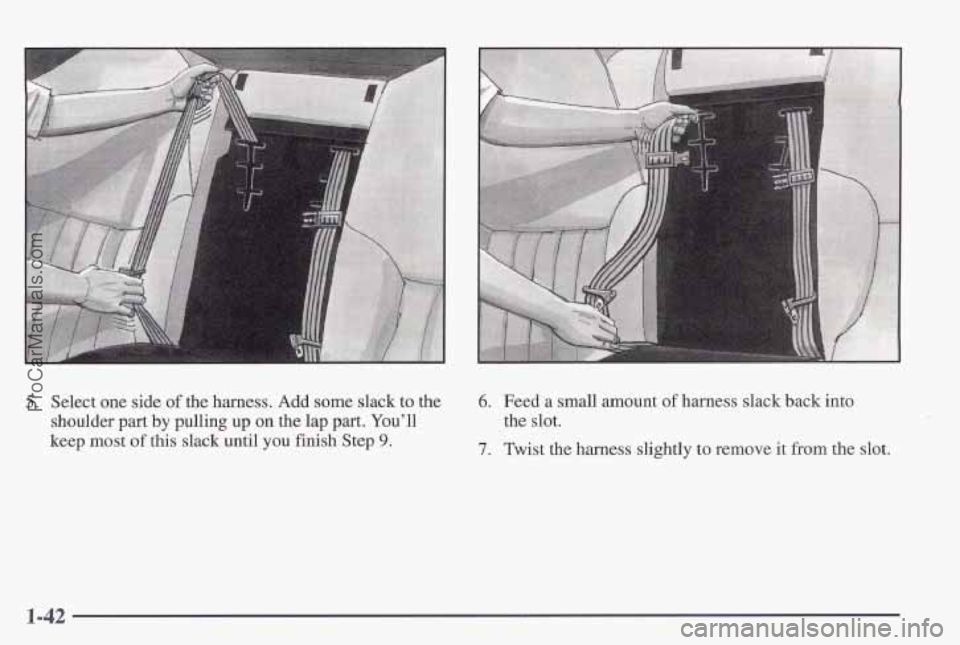
5. Select one side of the harness. Add some slack to the
shoulder part by pulling up on the lap part. You’ll
keep most
of this slack until you finish Step 9.
6. Feed a small amount of harness slack back into
the slot.
7. Twist the harness slightly to remove it from the slot.
1-42
ProCarManuals.com
Page 51 of 419

8. Move the harness up or down to the correct slot. The
correct slot is the one that will be at or just above the
top
of the child’s shoulder.
9. Twist the hamess slightly to ruute it through the
. correct slot.
10. Pull on the harness. Make sure it is properly routed
11. Repeat Steps 5 through 10 for the other side of
and isn’t twisted or
flipped over.
the harness. Be sure both sides
are adjusted to
the same height.
1-43
ProCarManuals.com
Page 71 of 419
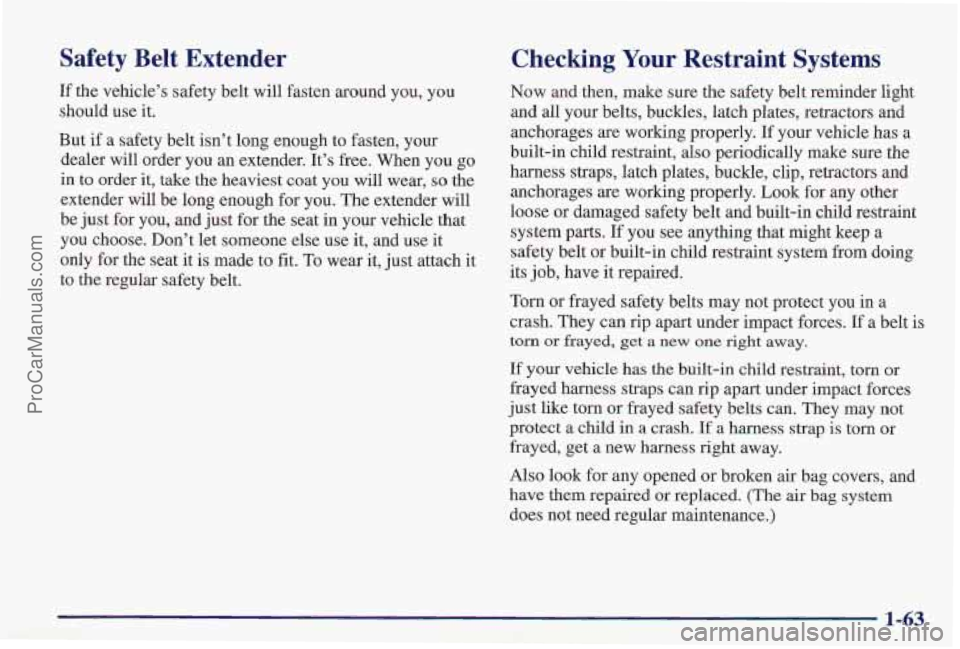
Safety Belt Extender
If the vehicle’s safety belt will fasten around you, you
should use it.
But
if a safety belt isn’t long enough to fasten, your
dealer will order you an extender. It’s free. When you
go
in to order it, take the heaviest coat you will wear, so the
extender will be long enough for you. The extender will
be just for you, and just for the seat in your vehicle that
you choose. Don’t let someone else use it, and use it
only for the seat it is made to fit. To wear it, just attach it
to the regular safety belt.
Checking Your Restraint Systems
Now and then, make sure the safety belt reminder light
and all your belts, buckles, latch plates, retractors and
anchorages are working properly.
If your vehicle has a
built-in child restraint, also periodically make sure the
harness straps, latch plates, buckle, clip, retractors and
anchorages are working properly.
Look for any other
loose or damaged safety belt and built-in child restraint
system parts. If you see anything that might keep a
safety belt or built-in child restraint system from doing
its job, have it repaired.
Torn or frayed safety belts may not protect you in a
crash. They can rip apart under impact forces.
If a belt is
torn or frayed, get a new one right away.
If your vehicle has the built-in child restraint, torn or
frayed harness straps can rip apart under impact forces
just like torn or frayed safety belts can. They may not
protect a child in a crash.
If a harness strap is torn or
frayed, get a new harness right away.
Also look for any opened or broken air bag covers, and
have them repaired or replaced.
(The air bag system
does not need regular maintenance.)
1-63
ProCarManuals.com
Page 75 of 419
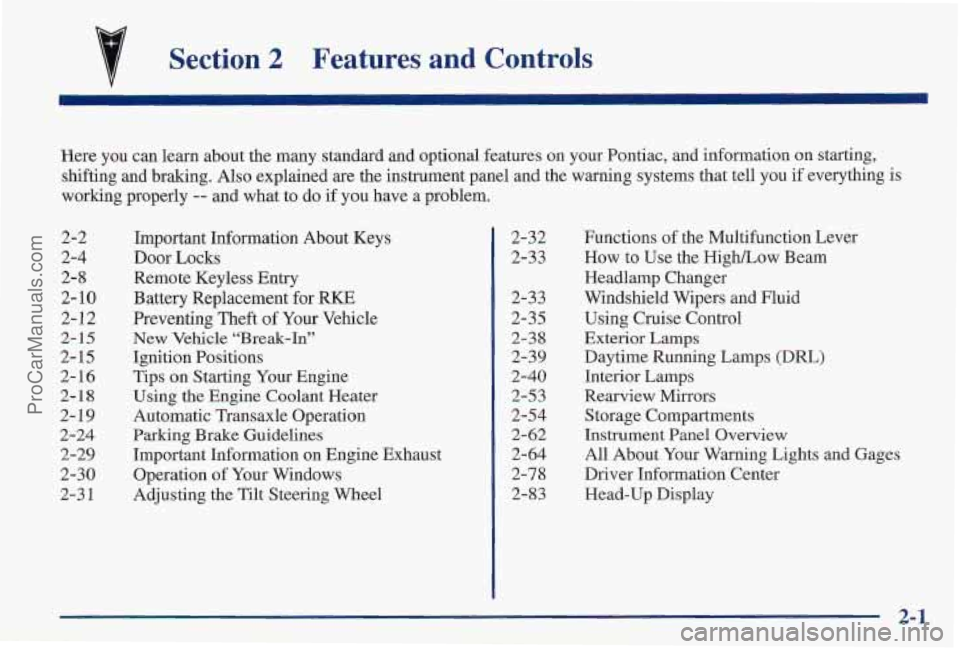
v Section 2 Features and Controls
Here you can learn about the many standard and optional features on your Pontiac, and information on starting,
shifting and braking. Also explained are the instrument panel and the warning systems that tell you if everything is
working properly
-- and what to do if you have a problem.
2-2
2-4
2-8
2- 10
2-12
2-15
2-15
2- 16
2-18
2-19
2-24
2-29
2-30
2-3 1
Important Information About Keys
Door Locks
Remote Keyless Entry Battery Replacement for RKE
Preventing Theft
of Your Vehicle
New Vehicle “Break-In”
Ignition Positions
Tips on Starting Your Engine
Using the Engine Coolant Heater
Automatic Transaxle Operation
Parking Brake Guidelines
Important Information on Engine Exhaust
Operation of Your Windows
Adjusting the Tilt Steering Wheel 2-32
2-33
2-33
2-35
2-3 8
2-39
2-40
2-5 3
2-54
2-62
2-64
2-78
2-83
Functions of the Multifunction Lever
How to Use the HighLow Beam
Headlamp Changer
Windshield Wipers and Fluid
Using Cruise Control
Exterior Lamps
Daytime Running Lamps
(DRL)
Interior Lamps
Rearview Mirrors
Storage Compartments
Instrument Panel Overview
All About Your Warning Lights and Gages
Driver Information Center
Head-Up Display
2-1
ProCarManuals.com
Page 79 of 419
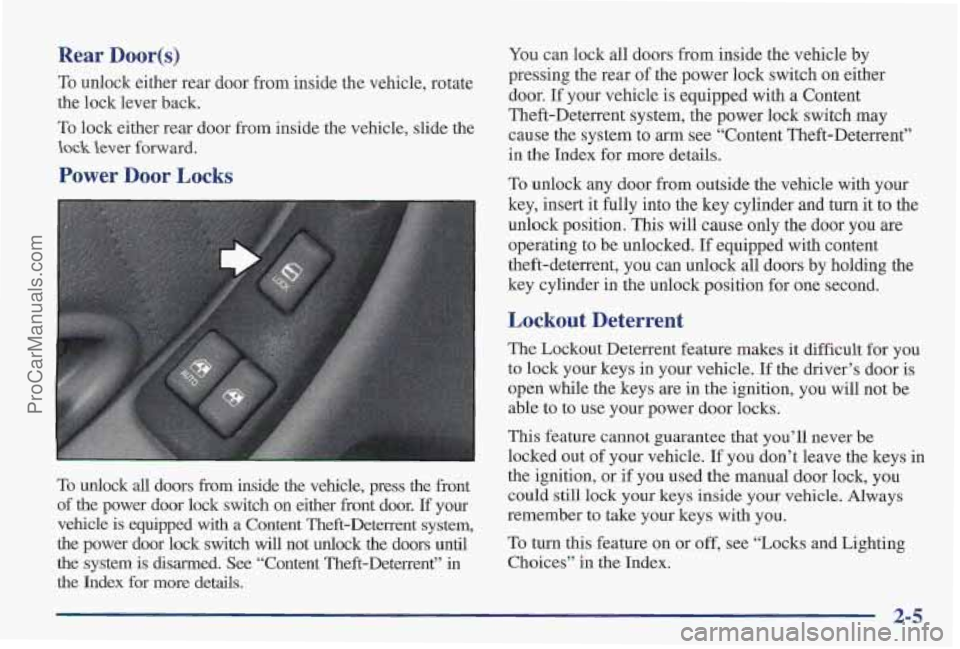
Rear Door(s)
To unlock either rear door from inside the vehicle, rotate
the lock lever back.
To lock either rear door from inside the vehicle, slide the
lock lever forward.
Power Door Locks
To unlock all doors from inside the vehicle, press the fiont
of
the power door lock switch on either front door. If your
vehicle is equipped with a Content Theft-Deterrent system,
the power door lock switch will not unlock
the doors until
the system
is disarmed. See “Content Theft-Deterrent” in
the Index for more details.
You can lock all doors from inside the vehicle by
pressing the rear
of the power lock switch on either
door. If your vehicle is equipped with
a Content
Theft-Deterrent system, the power lock switch may
cause the system
to arm see “Content Theft-Deterrent”
in the Index for more details.
To unlock any door from outside the vehicle with your
key, insert it fully into the key cylinder and turn it to the
unlock position. This will cause only the door you
are
operating to be unlocked. If equipped with content
theft-deterrent, you can unlock all doors by holding the
key cylinder in the unlock position for one second.
Lockout Deterrent
The Lockout Deterrent feature makes it difficult for you
to lock your keys in your vehicle. If the driver’s door is
open while the keys are in the ignition, you will not be
able to to use your power door locks.
This feature cannot guarantee that you’ll never be
locked out of your vehicle.
If you don’t leave the keys in
the ignition, or if you used the manual door lock, you
could still lock your keys inside your vehicle. Always
remember to take your keys with you.
To turn this feature on or off, see “Locks and Lighting
Choices” in the Index.
2-5
ProCarManuals.com